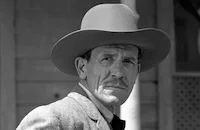Seminole Uprising
Brief Synopsis
Cast & Crew
Earl Bellamy
George Montgomery
Karin Booth
William Fawcett
Steve Ritch
Ed Hinton
Film Details
Technical Specs

Synopsis
In 1855, Black Cat, a chief of mixed Seminole and Caucasian descent, escapes from a Florida reservation, heads for Texas and leads a series of attacks on settlers there. Robert E. Lee sends for Lt. Cam Elliott, who, half Indian himself, had known Black Cat as a boy, and orders him to Fort Clark to assist Col. Hannah in subduing the troublesome Seminole. Cam accompanies his scout, Cubby Crouch, to Fort Clark, where he encounters Hannah's daughter Susan, who had once allowed Cam to make love to her. Cam assumed Susan had rejected him because of his Indian blood, but Susan now claims she bears no ill will against Indians and that she hopes Cam will court her again. Cam still loves Susan, but when he learns that Fort Clark's Capt. Phillip Dudley plans to marry her as soon as he settles his debts, he decides to avoid her. Cam plans to lead his own unit into battle with Black Cat, while a small detachment of cavalrymen, led by Dudley, takes several Seminole women and children as hostages. In exchange for the hostages, Cam hopes Black Cat will surrender two prisoners, the wife and son of a local settler named Toby Wilson. As Dudley is capturing Black Cat's wife and son, Wilson unexpectedly arrives on the scene. Learning that the Indians have killed his wife and son, Wilson quietly promises to relieve Dudley of all his debts in exchange for Black Cat's family. Dudley agrees, and Wilson later kills both the woman and the boy. Assuming that Hannah is responsible, Black Cat asks to meet Cam in private, greeting him as his brother Grey Eagle. The Seminole explains that Wilson's wife and son were killed because they tried to stab a Seminole woman, but that his own family was innocent of any wrongdoing. After threatening revenge, Black Cat rides away. When Cam and his men return to the fort, they find that Susan has been taken captive and the fort set on fire. Cam pursues the Seminoles across the desert, and Hannah orders Dudley to position a fresh water supply on the lieutenant's return route. Meanwhile, Susan, upon learning that Black Cat plans to trade her for guns, asks the chief if his sons will forgive him for having prevented them from becoming civilized. Cam defeats Black Cat's braves in a surprise attack from the hills, whereupon the chief agrees to send his people back to the reservation and to stand trial himself at Fort Clark. Dudley secretly empties the water barrels meant for Cam's men, and when young soldier Tony Zanoba discovers his treachery, he kills the captain. Black Cat, who feels Cam and Susan can help his people, shows them how to find water hidden under the sand just as Susan is about to die of thirst. She revives and declares her love for Cam, and the party returns to the fort with Black Cat, who reveals to Cam that in reality he is not a half-breed, as both of Cam's parents were white, and Cam was found in a wagon by the Seminoles. In the end, Cubby explains, Black Cat realized that Texas had to be tamed sooner or later.

Director
Earl Bellamy
Cast

George Montgomery
Karin Booth
William Fawcett
Steve Ritch
Ed Hinton
John Pickard
Jim Moloney
Rory Mallinson
Howard Wright
Russ Conklin
Jonni Paris
Joanne Rio
Richard Cutting
Paul Mcguire

Kenneth Macdonald
Rube Schaffer
Edward Coch
Crew
Mischa Bakaleinikoff
Leon Chooluck
Sidney Clifford
Jack Corrick
Francis Cugat
Jack Erickson
Henry Freulich
Sam Katzman
Robert E. Kent
George Lait
John Livadary
Paul Palmentola
Jerome Thoms
Josh Westmoreland

Film Details
Technical Specs

Quotes
Trivia
Notes
The working title of this film was Bugle's Wake. The film opens with voice-over narration spoken by William Fawcett as "Cubby Crouch" explaining that, in 1855, the Indian chief "Black Cat" incited the Indians to attack the settlers in Texas. Although the first two Seminole Wars took place in Florida, the third war, from 1855-1858, was fought in Texas. In its review, Hollywood Reporter commented, "one wonders why [screenwriter Robert E.] Kent decided to call these horse Indians, operating on the Texas plains, Seminoles. The Seminoles were canoe Indians native to the Florida swamps. Sometimes one wonders if some secret rule of the [PCA] Johnston office stipulates that there must be one major inaccuracy in every Indian picture." Reviewers also noted that the film included stock shots in the battle scenes.












